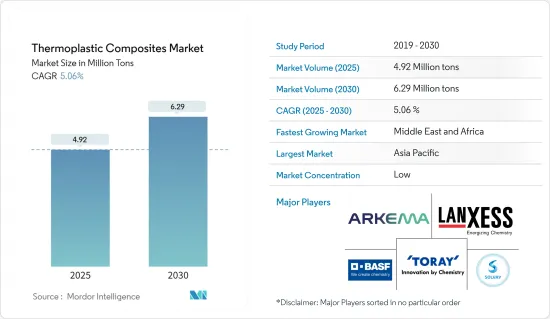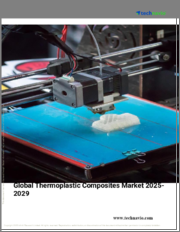
|
시장보고서
상품코드
1687373
세계의 열가소성 복합재료 시장 : 점유율 분석, 산업 동향 및 통계, 성장 예측(2025-2030년)Thermoplastic Composites - Market Share Analysis, Industry Trends & Statistics, Growth Forecasts (2025 - 2030) |
||||||
세계의 열가소성 복합재료 시장 규모는 2025년 492만톤으로 추정되며, 예측 기간 중(2025-2030년) CAGR 5.06%로 확대되어, 2030년에는 629만톤에 달할 것으로 예측되고 있습니다.

COVID-19의 팬데믹은 세계적 규모로 자동차 제조업체, 풍력 터빈 제조업체, 항공기 제조업체의 조업 정지를 강요시켜, 2020년의 복합재료 수요를 저하시켰습니다. 제조 수요부터 인재 개발, 팬데믹 발생 시 이미 진행된 동향의 가속과 감속에 이르기까지 복합재료 업계의 거의 모든 측면에 영향을 주었습니다.
주요 하이라이트
- 중기적으로는 건설 업계에서의 수요 증가와 항공우주 및 방위용도에 대한 투자 증가가 시장을 견인하는 주된 요인입니다
- 그 반면, 자동차 산업의 쇠퇴와 COVID-19 팬데믹의 악영향이 시장 성장을 억제할 가능성이 있습니다.
- 아시아태평양이 가장 높은 시장 점유율을 차지하고 있으며 예측 기간 동안이 지역이 시장을 독점할 것으로 예상됩니다.
열가소성 복합재료 시장 동향
자동차산업이 시장을 독점
- 자동차는 열가소성 복합재료의 주요 최종 사용자 산업입니다. 경량으로 CO2 배출량이 적은 자동차를 생산하는 수요가 높아져 자동차 산업에 있어서의 열가소성 복합재료 수요를 견인하고 있습니다.
- 열가소성 복합재료는 높은 인성과 경량이라는 특성으로 알려져 있습니다. 자동차 산업은 다양한 용도에 유리 매트 열가소성 수지를 채용하고 있습니다.
- 자동차 산업의 열가소성 복합재료의 응용 분야에는 시트 프레임, 배터리 트레이, 범퍼 빔, 로드 플로어, 프론트 엔드, 밸브 커버, 로커 패널, 언더 엔진 커버 등이 있습니다.
- Organisation Internationale des Constructeurs d'Automobiles(OICA)에 따르면 2022년 세계에서 제조된 자동차는 8,501만 6,728대를 넘어 전년대비 6% 증가하여 열가소성 복합재료를 기반으로 한 자동차 부품 제조에 의한 열가소성 복합재료 수요 증가를 나타내고 있습니다.
- 게다가 미국의 자동차 생산 대수는 2022년에 전년 대비 10% 증가했습니다. 캐나다, 멕시코, 미국은 생산대수가 10% 증가해, 총 생산 대수는 각각 122만 8,735대, 350만 9,072대, 1,006만 339대에 달했습니다. 남미 지역에서는 콜롬비아의 생산 대수가 전년 동월 대비 가장 증가해 26% 증가한 5만 1,455대에 이르렀습니다.
- 게다가 2022년 미국의 자동차 제조 기업은 국내 EV 제조에 130억 달러를 투자한다고 발표했습니다. Toyota는 캐롤라이나 주 제조시설에 25억 달러를 투자한다고 발표했습니다. Honda와 LG Energy Solution은 EV와 배터리 제조에 대한 투자로 44억 달러의 합작사업을 발표했습니다.
- 유럽에서는 독일이 주요 자동차 제조국 중 하나입니다. 독일 자동차 공업회(VDA)에 따르면, 독일의 2023년 3월의 자동차 생산 대수는 44만 1,990대로, 전년 동월 대비 67% 증가했습니다.
- 이와 같이 세계의 다양한 지역에서 자동차의 성장 동향과 생산을 고려하면 자동차 산업이 시장을 독점할 가능성이 높아 그 결과 예측 기간 중에 열가소성 복합재료 수요가 높아질 것으로 예상됩니다.
아시아태평양을 지배하는 중국
- 아시아태평양에서는 중국이 최대의 열가소성 복합재료의 제조 및 소비국이며, 인도, 일본이 이에 이어집니다.
- 이 나라에서는 정확한 품질로 업계의 요구에 맞는 폭넓은 제품을 생산할 수 있다는 장점에서 자동차 분야에서의 열가소성 복합재료의 높은 수요가 있습니다. 중국의 자동차 시장은 COVID-19 팬데믹의 발생, 구조적인 칩 부족, 지역의 지정학적 분쟁 등, 몇가지 마이너스 요인의 영향에도 불구하고, 2022년에는 플러스 성장을 이루었습니다.
- 중국 기차공업협회(CAAM)에 따르면 중국은 세계 최대의 자동차 생산기지를 갖고 있으며, 2022년의 자동차총생산대수는 2,700만대로 전년의 2,600만대에 비해 3.4% 증가를 기록했습니다.
- 공식 데이터에 따르면 중국의 일렉트로닉스 부문은 2022년에 안정적인 성장을 기록해 생산과 투자 면에서 견실한 성장을 지원했습니다. 공업정보화성에 의하면 동 부문의 주요 기업 부가가치액은 2021년 동기 대비 7.6% 증가하여 전산업의 부가가치액을 4% 웃돌았습니다.
- 국제무역기관에 따르면 중국은 세계 최대의 건설시장이며 도시화율은 세계 제일입니다.
- 중국 정부는 경제부양책 강구하고 있습니다. 중국의 제14차 5개년 계획에는 정부 주도로 건축 및 건설 프로세스에 디지털 기술을 응용하는 대처가 담겨 있습니다. 또한 건설 산업은 2025년까지 이 나라의 GDP의 6%를 차지할 것으로 예상되고 있습니다.
- 항공우주 기업 Airbus가 2023년 4월 발표한 보도 자료에 따르면 향후 20년간 중국 항공 수송량은 연률 5.3%로 성장해 세계 평균의 3.6%를 크게 웃돌 것으로 예측됩니다. 이 때문에 2041년까지 8,420기의 여객기와 화물기가 필요해, 이것은 향후 20년간에 세계에서 필요로 하는 신기재, 약 39,500기의 20% 이상에 상당합니다.
- 따라서, 상기의 이유에 의해 예측 기간중, 중국이 아시아태평양 시장 성장을 견인한다고 생각됩니다.
열가소성 복합재료 산업 개요
세계의 열가소성 복합재료 시장은 세계 수준에서도 지역 수준에서도 여러 기업이 사업을 전개하고 있으며, 그 성질상 부분적으로 단편화되어 있습니다.
기타 혜택
- 엑셀 형식 시장 예측(ME) 시트
- 3개월간의 애널리스트 서포트
목차
제1장 서론
- 조사의 전제조건
- 조사 범위
제2장 조사 방법
제3장 주요 요약
제4장 시장 역학
- 성장 촉진요인
- 자동차 산업에서의 수요 증가
- 건설 업계의 소비 증가
- 억제요인
- 원재료의 고비용과 열가소성 복합재 성형의 과제
- 기타
- 업계 밸류체인 분석
- Porter's Five Forces 분석
- 공급기업의 협상력
- 구매자의 협상력
- 신규 참가업체의 위협
- 대체품의 위협
- 경쟁도
제5장 시장 세분화
- 수지 유형별
- 폴리프로필렌(PP)
- 폴리아미드(PA)
- 폴리에테르에테르케톤(PEEK)
- 기타
- 섬유 유형별
- 유리 섬유
- 탄소섬유
- 기타
- 제품 유형별
- 단섬유 열가소성 수지(SFT)
- 장섬유 열가소성 수지(LFT)
- 연속 섬유 열가소성 수지(CFT)
- 유리 매트 열가소성 수지(GMT)
- 최종 사용자 산업별
- 항공우주 및 방위
- 전기 및 전자
- 자동차
- 건축
- 의료
- 기타
- 지역별
- 아시아태평양
- 중국
- 인도
- 일본
- 한국
- ASEAN 국가
- 기타 아시아태평양
- 북미
- 미국
- 캐나다
- 멕시코
- 유럽
- 독일
- 영국
- 프랑스
- 이탈리아
- 기타 유럽
- 남미
- 브라질
- 아르헨티나
- 기타 남미
- 중동 및 아프리카
- 사우디아라비아
- 남아프리카
- 기타 중동 및 아프리카
- 아시아태평양
제6장 경쟁 구도
- M&A, 합작사업, 제휴, 협정
- 시장 점유율(%)**/순위 분석
- 주요 기업의 전략
- 기업 프로파일
- Arkema SA
- AVANCO Group
- Avient Corporation
- BASF SE
- Celanese Corporation
- Daicel Corporation
- DSM
- Hexcel Corporation
- LANXESS
- LyondellBasell Industries Holdings BV
- Mitsubishi Chemical Group Corporation
- SABIC
- SGL Carbon
- Solvay
- TechnoCompound GmbH
- Toray Industries Inc.
제7장 시장 기회와 앞으로의 동향
- 헬스케어 분야에 있어서의 폭넓은 응용 범위
- 항공우주 및 방위산업에서의 수요 증가
The Thermoplastic Composites Market size is estimated at 4.92 million tons in 2025, and is expected to reach 6.29 million tons by 2030, at a CAGR of 5.06% during the forecast period (2025-2030).

The COVID-19 pandemic, on a global scale, has forced automakers, wind turbine manufacturers, and aircraft manufacturers to shut down their operations, lowering the demand for composites in 2020. The pandemic impacted almost every aspect of the composites industry, from product demand to workforce development to the acceleration or deceleration of trends that were already underway when it struck. Customers and their own temporary production stop reduced the production levels, and demand reductions have all had a significant impact on production processes.
Key Highlights
- In the medium term, the major factors driving the market studied are the increasing demand from the construction industry and increasing investments in aerospace and defense applications.
- On the flip side, the declining automotive industry and the negative impact of the COVID-19 pandemic are likely to restrain the market growth.
- Asia-Pacific accounted for the highest market share, and the region is likely to dominate the market during the forecast period.
Thermoplastic Composites Market Trends
Automotive Industry to Dominate the Market
- Automotive is the major end-user industry of thermoplastic composites. The growing demand for producing lightweight and low CO2 emission vehicles is driving the demand for thermoplastic composites in the automotive industry.
- Thermoplastic composites are known for their high toughness and lightweight characteristics. Automotive industries highly adopt glass mat thermoplastics for various uses.
- The application areas of these composites in the automotive industry include seat frames, battery trays, bumper beams, load floors, front ends, valve covers, rocker panels, and under-engine covers.
- According to the Organisation Internationale des Constructeurs d'Automobiles (OICA), more than 85,016,728 motor vehicles were manufactured worldwide in 2022, an increase of 6% from a year earlier, indicating an increased demand for thermoplastic composites from thermoplastic composite-based automotive part manufacturing.
- Additionally, America's automotive production grew by 10% Y-o-Y in 2022. Canada, Mexico, and the United States saw a production increase of 10%, with motor vehicle production reaching 12,28,735 units, 35,09,072 units, and 1,00,60,339 units, respectively. In the South American region, Colombia saw the greatest rise in Y-o-Y production, reaching 51,455 units, an increase of 26%. Argentina also saw a massive 24% increase, with production reaching 5,36,893 units.
- Moreover, in 2022, US auto manufacturing companies announced a USD 13 billion investment in domestic EV manufacturing, more than triple the investment in 2020. Toyota announced a USD 2.5 billion investment in the Carolina manufacturing facility. Honda and LG Energy Solution announced a USD 4.4 billion joint venture for investments in EV and battery manufacturing. These factors are expected to ascend vehicle production, thereby benefiting the thermoplastic composites market.
- In Europe, Germany is among the key manufacturer of vehicles. According to the German Association of the Automotive Industry (VDA), Germany produced 441,990 units of vehicles in March 2023, a growth of 67% compared to the number of vehicles produced in the month of March in the previous year.
- Thus, considering the growth trends and production of automobiles in different regions worldwide, the automotive industry is likely to dominate the market, which, in turn, is expected to enhance the demand for thermoplastic composites during the forecast period.
China to Dominate the Asia-Pacific Region
- China is the largest manufacturer and consumer of thermoplastic composites in the Asia-Pacific region, followed by India and Japan.
- The use of thermoplastic composites in the automotive sector in the country is in high demand, owing to the advantage of producing a wide range of products that fit the industry's needs with precise quality. China is the world's biggest automobile market in terms of both production and sales. China's automotive market experienced positive growth in 2022 despite the impact of several negative factors, including the occurrence of the COVID-19 pandemic, a structural chip shortage, and local geopolitical conflicts.
- According to the China Association of Automobile Manufacturers (CAAM), China has the largest automotive production base in the world, with a total vehicle production of 27 million units in 2022, registering an increase of 3.4% compared to 26 million units produced in the previous year.
- According to official data, China's electronics sector recorded stable growth in 2022, supporting solid growth in terms of production and investment. According to the Ministry of Industry and Information Technology, the value added of major enterprises in the sector increased by 7.6% over the same period in 2021, exceeding the value added of all industries by 4%. Thus, a significant boost in demand for electronic goods supports the demand for thermoplastic composites from the industry.
- According to the International Trade Organization, China is the world's largest construction market and has the highest rate of urbanization globally. According to data from the American Institute of Architects (AIA) Shanghai, by 2025, China is anticipated to build a city equivalent to 10 New York City's worth of city space since the 1990s.
- The Chinese government is taking steps to tighten the economy. China's 14th Five-Year Plan includes a government-led effort to apply digital technology to the building and construction process. Furthermore, the construction industry is expected to account for 6% of the country's GDP by 2025. China's construction sector plays an increasingly important role in stimulating the economy and stabilizing employment.
- According to aerospace company Airbus' press release in April 2023, over the next 20 years, China's air traffic is projected to grow at an annual rate of 5.3%, well above the global average of 3.6%. This would require 8,420 passengers and freighters by 2041, or more than 20% of the world's need for new aircraft over the next 20 years, around 39,500.
- Hence, due to the reasons mentioned above, China is likely to drive the market's growth in the Asia-Pacific region during the forecast period.
Thermoplastic Composites Industry Overview
The global thermoplastic composites market is partially fragmented in nature, with several companies operating on both global and regional levels. Some of the major companies in the market include LANXESS, Solvay, BASF SE, Toray Industries Inc., and Arkema SA, among others.
Additional Benefits:
- The market estimate (ME) sheet in Excel format
- 3 months of analyst support
TABLE OF CONTENTS
1 INTRODUCTION
- 1.1 Study Assumptions
- 1.2 Scope of the Study
2 RESEARCH METHODOLOGY
3 EXECUTIVE SUMMARY
4 MARKET DYNAMICS
- 4.1 Drivers
- 4.1.1 Increasing Demand from the Automotive Industry
- 4.1.2 Rising Consumption in the Construction Industry
- 4.2 Restraints
- 4.2.1 High Cost of Raw Materials and Challenges to Form Thermoplastic Composites
- 4.2.2 Other Restraints
- 4.3 Industry Value Chain Analysis
- 4.4 Porter's Five Forces Analysis
- 4.4.1 Bargaining Power of Suppliers
- 4.4.2 Bargaining Power of Buyers
- 4.4.3 Threat of New Entrants
- 4.4.4 Threat of Substitute Products and Services
- 4.4.5 Degree of Competition
5 MARKET SEGMENTATION (Market Size in Volume)
- 5.1 Resin Type
- 5.1.1 Polypropylene (PP)
- 5.1.2 Polyamide (PA)
- 5.1.3 Polyetheretherketone (PEEK)
- 5.1.4 Other Resin Types
- 5.2 Fiber Type
- 5.2.1 Glass Fiber
- 5.2.2 Carbon Fiber
- 5.2.3 Other Fiber Types
- 5.3 Product Type
- 5.3.1 Short Fiber Thermoplastic (SFT)
- 5.3.2 Long Fiber Thermoplastic (LFT)
- 5.3.3 Continuous Fiber Thermoplastic (CFT)
- 5.3.4 Glass Mat Thermoplastic (GMT)
- 5.4 End-user Industry
- 5.4.1 Aerospace and Defense
- 5.4.2 Electrical and Electronics
- 5.4.3 Automotive
- 5.4.4 Construction
- 5.4.5 Medical
- 5.4.6 Other End-user Industries
- 5.5 Geography
- 5.5.1 Asia-Pacific
- 5.5.1.1 China
- 5.5.1.2 India
- 5.5.1.3 Japan
- 5.5.1.4 South Korea
- 5.5.1.5 ASEAN Countries
- 5.5.1.6 Rest of Asia-Pacific
- 5.5.2 North America
- 5.5.2.1 United States
- 5.5.2.2 Canada
- 5.5.2.3 Mexico
- 5.5.3 Europe
- 5.5.3.1 Germany
- 5.5.3.2 United Kingdom
- 5.5.3.3 France
- 5.5.3.4 Italy
- 5.5.3.5 Rest of Europe
- 5.5.4 South America
- 5.5.4.1 Brazil
- 5.5.4.2 Argentina
- 5.5.4.3 Rest of South America
- 5.5.5 Middle East and Africa
- 5.5.5.1 Saudi Arabia
- 5.5.5.2 South Africa
- 5.5.5.3 Rest of Middle East and Africa
- 5.5.1 Asia-Pacific
6 COMPETITIVE LANDSCAPE
- 6.1 Mergers and Acquisitions, Joint Ventures, Collaborations, and Agreements
- 6.2 Market Share (%) **/Rank Analysis
- 6.3 Strategies Adopted by Leading Players
- 6.4 Company Profiles
- 6.4.1 Arkema SA
- 6.4.2 AVANCO Group
- 6.4.3 Avient Corporation
- 6.4.4 BASF SE
- 6.4.5 Celanese Corporation
- 6.4.6 Daicel Corporation
- 6.4.7 DSM
- 6.4.8 Hexcel Corporation
- 6.4.9 LANXESS
- 6.4.10 LyondellBasell Industries Holdings BV
- 6.4.11 Mitsubishi Chemical Group Corporation
- 6.4.12 SABIC
- 6.4.13 SGL Carbon
- 6.4.14 Solvay
- 6.4.15 TechnoCompound GmbH
- 6.4.16 Toray Industries Inc.
7 MARKET OPPORTUNITIES AND FUTURE TRENDS
- 7.1 Wide Application Scope in the Healthcare Sector
- 7.2 Rising Demand from the Aerospace and Defense Industry



















